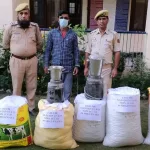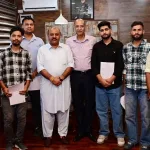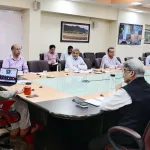Budgam, Oct 31: The iconic Karewas of Char-e-Sharief, nestled in Central Kashmir, were celebrated for their cultivation of cherished Kashmiri saffron.
This heritage crop, once a symbol of the region, faced a significant decline in recent years.
The culprit? Porcupines causing substantial damage to the saffron corms which led to farmers abandoning the crop after 2014.
However, Ali Mohammad, a visionary farmer, has taken it upon himself to preserve this legacy.
Ali Mohammad, who has dedicated many years to saffron farming, is one of the few remaining farmers in Char-e-Sharief who continue to cultivate this cash crop.
What sets him apart is his pioneering approach. Not content with traditional methods only, he embraced indoor saffron cultivation, inspired by Scientists of SKUAST-K’s Saffron Research Station Dussu Pampore.
The advantages of indoor saffron cultivation are manifold, as Ali Mohammad explained.
By cultivating saffron within indoor environments with ambient conditions, the crop is shielded from the ravages of rain and heat. Moreover, corms are safe from porcupine attacks, ensuring a healthier and more reliable yield.
In the past two years, Ali successfully trialled this method, and he’s now planning to expand his indoor saffron cultivation.
Last year, his harvest was modest, with corms of smaller size, but this season shows great promise. Corms have grown significantly, with each weighing around 16 grams, indicating a potentially bountiful yield.
Ali Mohammad’s optimism is well-founded, as he expects multiple pickings this season, thanks to the robust corms.
What’s more, the quality of indoor saffron has been demonstrated to be superior to that grown in open field conditions.
This innovative technique of Indoor Saffron Cultivation was introduced in 2021, with SKUAST-K facilitating the transfer of knowledge to a select group of farmers. The project received support from NABARD, providing farmers with corms, boxes, and essential training.
Experts have hailed this approach for its environmental resilience and its potential to benefit marginal farmers looking to enter the saffron market.
The technique involves placing corms inside boxes and subjecting them to a 90-100 day dark requirement in ultra-high-density modules. After harvest, corms are returned to the soil for chilling, making efficient use of space.
Ali Mohammad emphasized that indoor saffron cultivation comprises two phases. During the first phase, corms are procured in June-July and installed in multi-tier racks inside ambient rooms.
Flowers are harvested from October to November 10th. In phase two, corms are removed from racks and immediately placed under open field soil following a high-density module to ensure a steady supply of healthy and productive corms for the next season.
Ali has all praise for Scientists of SKUAST-K’s Saffron Research Station for their guidance and expert advice.





